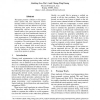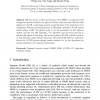757 search results - page 78 / 152 » Recognition Performance of a Structured Language Model |
ACL
2010
13 years 5 months ago
2010
One goal of natural language generation is to produce coherent text that presents information in a logical order. In this paper, we show that topological fields, which model high-...
ACL
2003
13 years 9 months ago
2003
This paper presents a Chinese word segmentation system that uses improved sourcechannel models of Chinese sentence generation. Chinese words are defined as one of the following fo...
AAAI
2010
13 years 9 months ago
2010
Multi-Agent Plan Recognition (MAPR) seeks to identify the dynamic team structures and team behaviors from the observations of the activity-sequences of a set of intelligent agents...
JIB
2007
13 years 7 months ago
2007
The creation of quantitative, simulatable, Systems Biology Markup Language (SBML) models that accurately simulate the system under study is a time-intensive manual process that re...
ISNN
2009
Springer
14 years 2 months ago
2009
Springer
SM has shown a better performance than HMM in connected word recognition system; however, no reports we have read show that SM has been applied in LVCSR as decoding acoustic model ...


